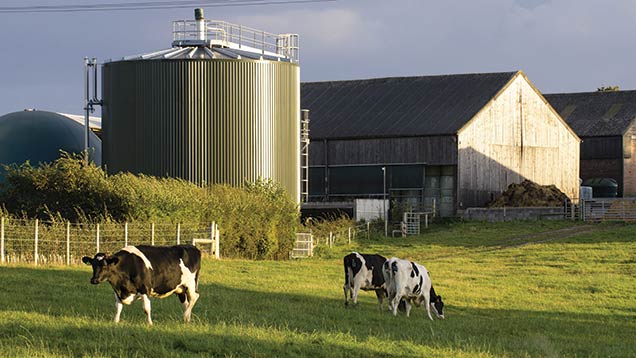UK lenders more open to AD and hydro schemes on farm
 (c) Global Warming Images/Rex
(c) Global Warming Images/Rex Hydro and AD have long been seen as higher-risk investments than simpler technologies such as solar and wind.
That may well still be the case, but high street banks appear to becoming more open to these schemes as more projects come on line and are able to demonstrate their performance.
NatWest/RBS recently announced it had extended its small-scale renewables policy (up to 1MW or max £5m lending) to take the future earnings from AD and hydro projects into consideration when assessing new funding propositions.
Up to 30% of future earnings from these technologies, such as electricity sales, Feed-in Tariffs or Renewable Heat Incentive income, will be taken into account when assessing the serviceability of any new loan, with the remaining 70% would be expected to be covered by existing income, such as the core farming business.
Previously other business income would have had to cover all of the loan repayment under a standard credit policy.
“We’d expect any client to do their own due diligence and feasibility first. In particular, look carefully at the experience and track record of your technology supplier; make sure the business plan reflects the true costs and returns and consider how well it fits with the core business; and finally consider how you will monitor performance of the project.”
Mark Suthern, Barcleys
See also: 10 steps to successful farm project planning
“Over the past few years we have built up a good understanding and robust processes for lending to wind and solar projects under our small-scale renewables policy, so it is a natural progression to extend it to include AD and hydro,” says head of agriculture and renewable energy Ian Burrow.
“AD and hydro represent a huge opportunity for farmers considering renewable energy in the UK and we’ve had a lot of requests to include these technologies.”
Other banks also report increasing interest in AD and hydro and insist they too are happy to include a proportion of future project income when assessing funding.
AMC, for example, says it will take a similar proportion of forecast income into account, while HSBC says it will consider up to 50% of future earnings from new projects, with cash from other income streams covering the remaining half.
Open for business
“Banks do appear to be becoming more open to these technologies [AD and hydro], but they still require a lot of reassurance,” says Cath Anthony of Bidwells.
“There is a fair degree of uncertainty to future income [from AD and hydro], so every project is assessed on its own merits,” says Gordon Whitford, HSBC regional agriculture manager for northern England and Northern Ireland.
One of the biggest risk factors for AD is feedstock availability and he says project developers need to demonstrate they have a secure supply for the period of the loan (typically 10 years), ideally longer.
“Often it’s about demonstrating an understanding of local markets and how the future availability of feedstocks could change,” says AMC regional agricultural manager Jon Drew.
“The principles are the same whether it’s a small or large-scale project, but by definition the numbers are bigger on larger projects, so the financial risk is greater.”
The capital costs associated with renewable projects, particularly AD, can potentially restrict borrowing capacity of the core business where loans are secured on existing land or buildings, Mr Whitford adds.
“It may well be a case of having to decide between investing in the core business or investing in renewables, not necessarily both, so it’s something to consider carefully.”
Indeed, while banks are willing to consider future revenue from planned projects and insist that serviceability of loans is the main factor when making lending decisions, most still require loans to be secured against existing assets.
Loan-to-value ratios vary, but in the case of NatWest/RBS, Mr Burrow says at least 75% security is required under its small-scale renewables policy. He says it may be possible to get land revalued to account for the uplift in value during the key stages of the project – for example, when planning permission is granted, once constructed, or when fully operational with a proven income generating capacity.
Diligent approach
Barclays also says it will take account of future project income, including savings from on-site use of power or heat generated. Head of agriculture Mark Suthern says the bank is keen to help farmers develop alternative revenue streams.
Even though AD and hydro technologies are becoming more established in the UK, he acknowledges they remain in a higher-risk category than wind and solar due to the number of variables involved – for example, river flows and feedstock variability. This makes it crucial for banks to conduct detailed due diligence – the checks they must make and financial tests they conduct before offering funding.
“We’d expect any client to do their own due diligence and feasibility first. In particular, look carefully at the experience and track record of your technology supplier; make sure the business plan reflects the true costs and returns and consider how well it fits with the core business; and finally consider how you will monitor performance of the project,” Mr Suthern advises.
